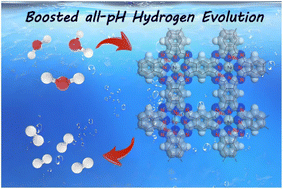Electronic structure optimization of metal–phthalocyanine via confining atomic Ru for all-pH hydrogen evolution†
Abstract
The eco-friendly production of hydrogen under actual working conditions is a promising method to address the energy crisis. However, the lack of an effective proton source and the sluggish electrolyzed water process have resulted in a large kinetics difference in hydrogen evolution under different pH conditions. Herein, we report a robust strategy to break the kinetic barriers of hydrogen evolution for all-pH conditions through two-dimensional metal-polyphthalocyanine confined well-dispersed Ru atoms (RuSA@NiFe PPc). Benefiting from the synergistic effect between active Ru and conjugated polymers through interfacial Ru–N bonds, RuSA@NiFe PPc displays prominent reactivity for the HER under both acidic and alkaline conditions, achieving an ultrasmall overpotential of 12 mV at 10 mA cm−2 that is nearly 50 times smaller than that of pristine NiFe PPc and outperforming that of the benchmark Pt/C catalyst, and durable stability ∼160 000 s at 200 mA cm−2. We further demonstrate that a high-performance membrane electrode assembly device with RuSA@NiFe PPc and a commercial IrO2 anode achieves a current density of 2.0 A cm−2 at a low voltage of only 2.27 V. Theoretical calculations reveal that the electronic structure optimization through Ru–N bridges induces the acceleration of activation/dissociation of water and adsorption of *H, thus breaking the deadlock of all-pH HER kinetics.



 Please wait while we load your content...
Please wait while we load your content...